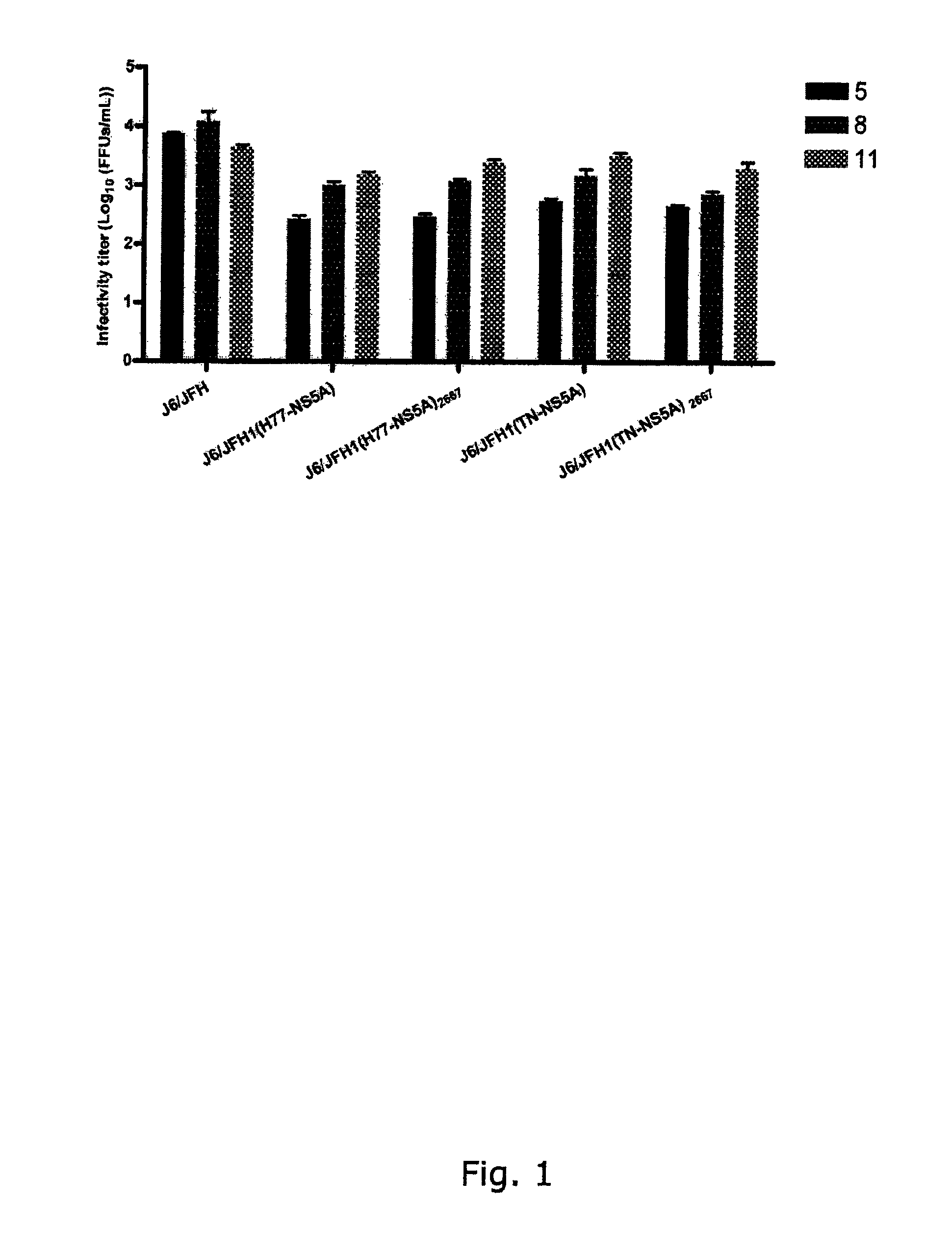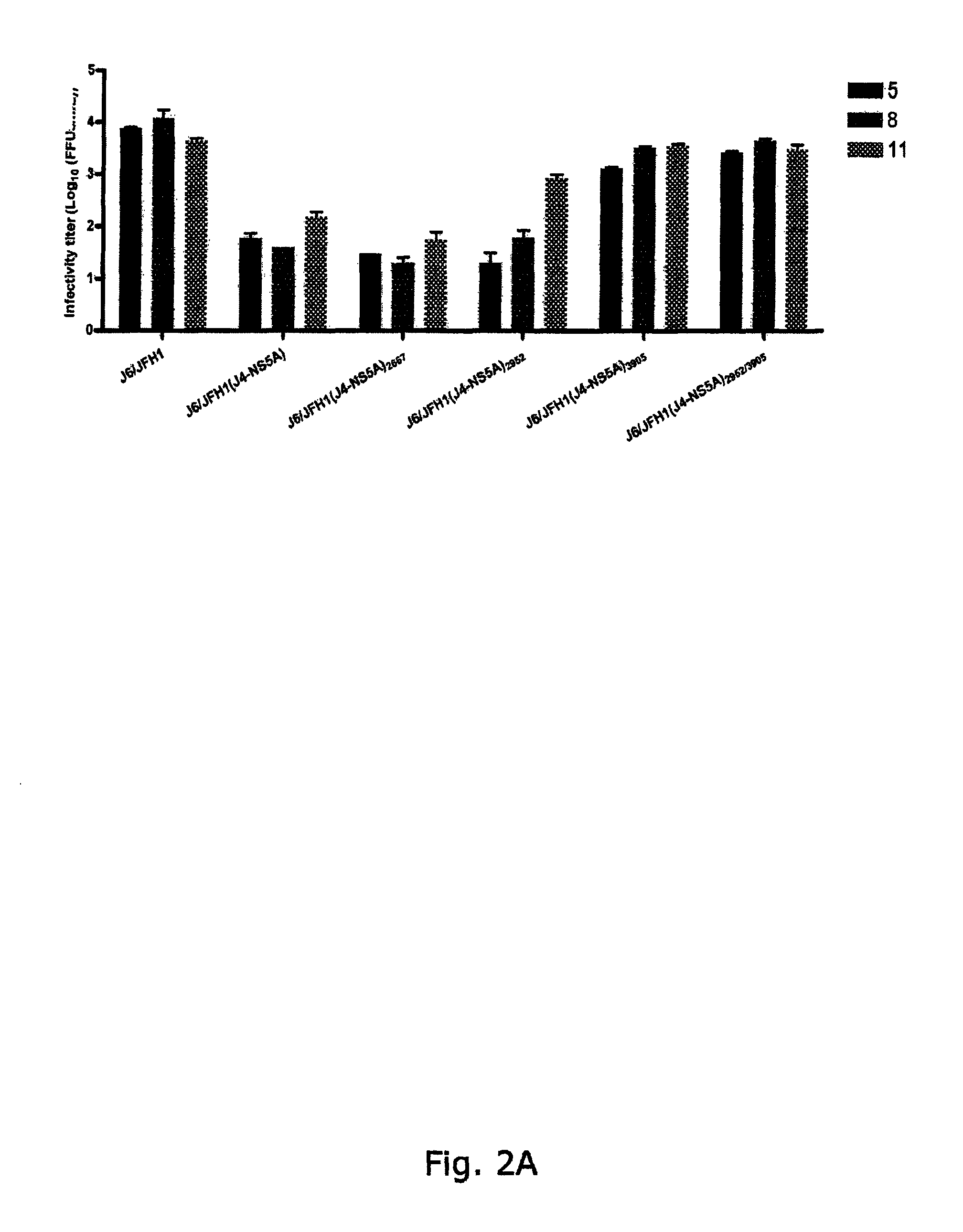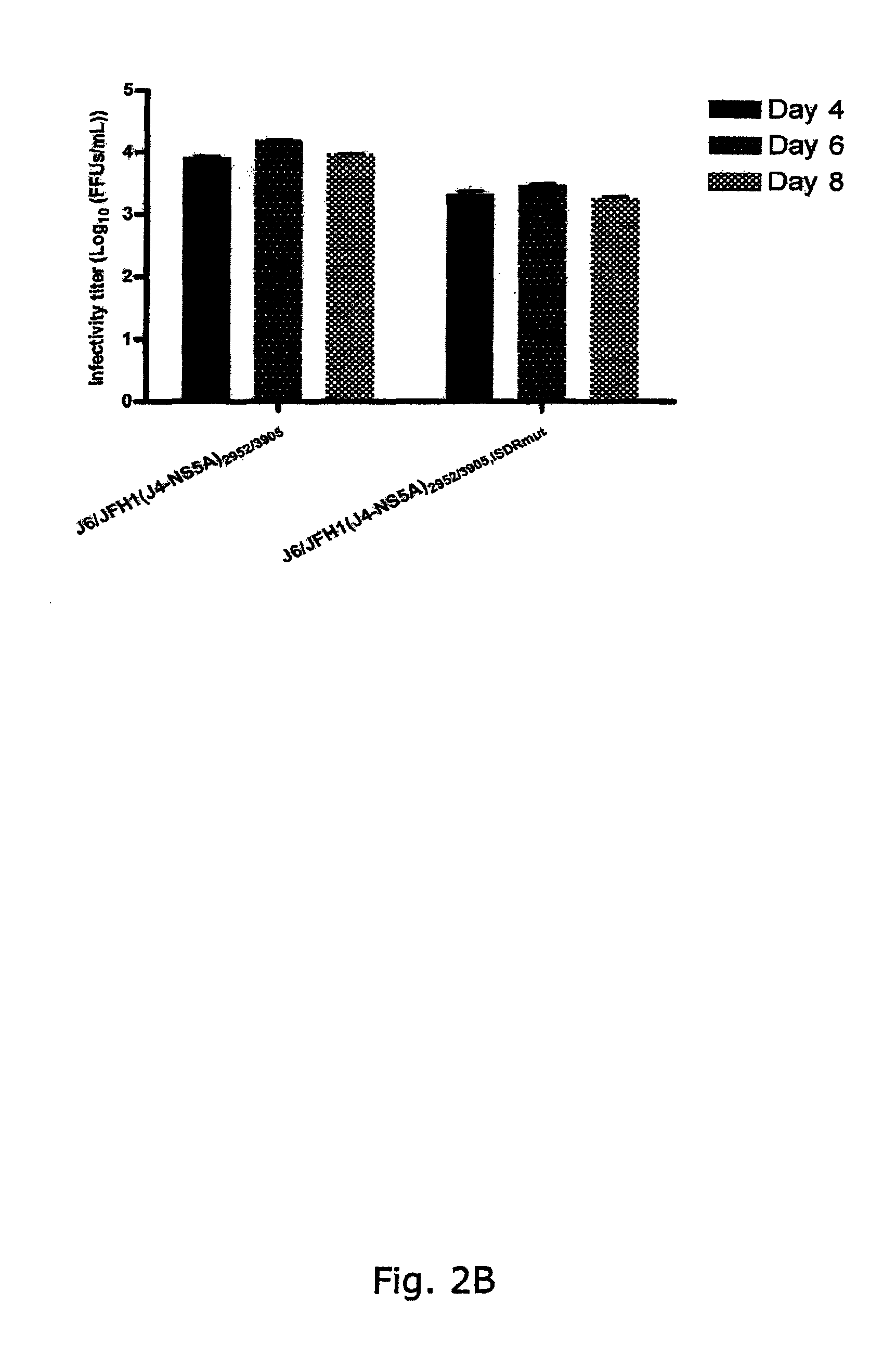JFH-1 based HCV cell culture systems for NS5A of genotypes 1-7
a cell culture system and hcv technology, applied in the field of infectious recombinant hepatitis c virus, can solve the problems of hepatocellular carcinoma, hcv research has been hampered, and the risk of liver cirrhosis is increased
- Summary
- Abstract
- Description
- Claims
- Application Information
AI Technical Summary
Benefits of technology
Problems solved by technology
Method used
Image
Examples
example 1
Materials & Method
Construction of JFH1-Based Recombinants with NS5A of Genotypes 1-7
[0285]For construction of J6 / JFH1 with genotype specific NS5A, the JFH1 NS5A sequence was replaced by the complete NS5A consensus sequence from genotypes 1-7 by standard fusion PCR (Pfu polymerase, Stratagene, La Jolla, Calif., USA) and cloning techniques.
[0286]NS5A was from isolate H77C (genotype 1a), HC-TN (1a), J4 (1b), 36 (2a), S52 (3a), ED43 (4a), SA13 (5a), HK6a (6a) or QC69 (7a). The NS5A consensus sequences of H77C, HC-TN, 34 and 36 were previously described (Yanagi et al. 1997; Yanagi et al. 1998; Yanagi et al. 1999; Sakai et al. 2007). NS5A consensus sequences of S52, ED43, SA13 and HK6a were obtained from chimpanzee infectious pools by RNA extraction (Highly Pure Viral Nucleic Acid Kit™, Roche, Mannheim, Del.), reverse-transcription (RT)-PCR (using Superscript III™, Invitrogen, Carlsbad, Calif., USA and Advantage 2 PCR Enzyme System™, Clontech, Mountain View, Calif.) cloning (TOPO-XL™ clon...
example 2
Development of J6 / JFH1-Based Cell Culture Systems for NS5A Genotypes 1-7
[0298]To generate genotype specific HCV cell culture systems for the NS5A gene, the complete NS5A sequence of J6 / JFH1 was replaced by reference isolates of genotype 1a (H77C or HC-TN), 1b (J4), 2a (J6), 3a (S52), 4a (ED43), 5a (SA13), 6a (HK6a) or 7a (QC69) (SEQ ID NO 1, 3, 5, 11, 13, 24, 33, 40 and 43, deduced amino acid SEQ ID NO 82, 84, 86, 92, 94, 105, 114, 121 and 124). RNA transcripts were transfected into Huh7.5 hepatoma cells and culture infection was followed by immunostaining for Core expression and by titration of infectivity released to supernatant. Spread of infection with J6 / JFH1 with NS5A from H77, TN, 36, S52 and QC69 was only slightly delayed compared to J6 / JFH1, and relatively high viral titers were produced after transfection (FIGS. 1, 3, 4, 8). J6 / JFH1 with NS5A from 34, ED43, SA13 and HK6a spread in culture on day 13, 10, 29 and 12 (In two additional transfections, J6 / JFH1(HK6a-NS5A) spread ...
example 3
Development of Efficient J6 / JFH1(1a-NS5A) System
[0299]The original constructs of J6 / JFH1(H77-NS5A) and J6 / JFH1(TN-NS5A) produced relatively high infectivity titers immediately after transfection and no additional mutations were identified after passage to naïve cells. The same was observed in repeated transfections with these constructs. For J6 / JFH1(H77-NS5A) maximum infectivity titers in transfection and 1st passage were 103.2 and 104.0 focus-forming units (FFU) / mL, respectively. J6 / JFH1(TN-NS5A) produced infectivity titers in transfection and 1st passage of 103.5 and 104.1 FFU / mL, respectively. Maximum RNA titers were 107.2 and 106.9 IU / mL for H77 and TN, respectively. Thus, efficient systems for H77 and TN NS5A had been developed (FIG. 1, Table 1a and Table 2). Since the p7 mutation T2667C was observed for several recombinants this change was introduced into J6 / JFH1(H77-NS5A) and J6 / JFH1(TN-NS5A) to investigate whether even higher infectivity titers could be achieved (SEQ ID NO 2...
PUM
| Property | Measurement | Unit |
|---|---|---|
| size | aaaaa | aaaaa |
| polarity | aaaaa | aaaaa |
| genetic heterogeneity | aaaaa | aaaaa |
Abstract
Description
Claims
Application Information
 Login to View More
Login to View More - R&D
- Intellectual Property
- Life Sciences
- Materials
- Tech Scout
- Unparalleled Data Quality
- Higher Quality Content
- 60% Fewer Hallucinations
Browse by: Latest US Patents, China's latest patents, Technical Efficacy Thesaurus, Application Domain, Technology Topic, Popular Technical Reports.
© 2025 PatSnap. All rights reserved.Legal|Privacy policy|Modern Slavery Act Transparency Statement|Sitemap|About US| Contact US: help@patsnap.com



